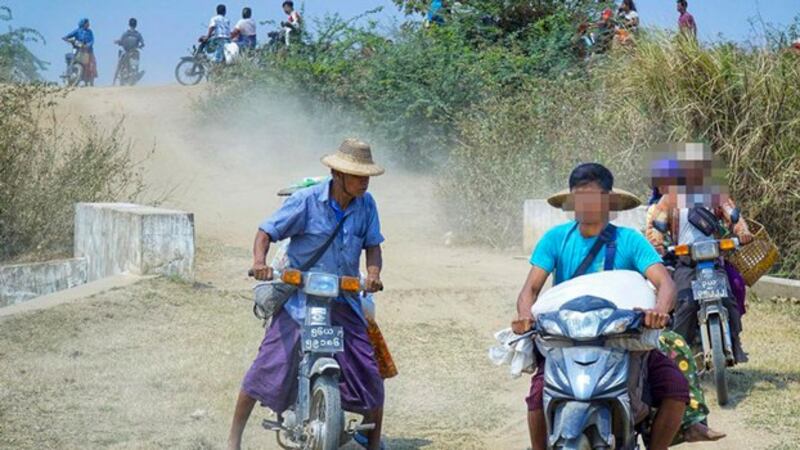UPDATED on May 16, 2024 at 3:40 p.m. ET
Intensifying conflict in Myanmar’s civil war has displaced more than 3 million civilians, according to the United Nations resident coordinator in the Southeast Asian country.
Since October 2023, when rebel groups began a coordinated offensive against the military junta, a growing number of people have been forced to flee their homes, according to a statement issued May 3 by the office of Marcoluigi Corsi, the U.N. resident and humanitarian coordinator in Myanmar.
The number of internally displaced persons, or IDPs, has jumped 50% in the past six months, it said.
“Myanmar stands at the precipice in 2024 with a deepening humanitarian crisis that has spiraled since the military takeover in February 2021 and the consequent conflicts in many parts of the country, driving record numbers of people to abandon their homes seeking safety,” the statement said.
About one-third of the displaced are children whose education has been disrupted, it said.
Myanmar’s widespread humanitarian crisis has left a total of 18.6 million people in need, 1 million more than in 2023, the U.N. statement said. Those in need make up more than one-third of Myanmar's 54 million people.
Chin state in the west, Sagaing region in the north and Magway region in the central part of the country have the highest number of IDPs at nearly 1.5 million people, it said.
Some towns deserted
Many people have been unable to return to their homes because of air attacks and the raiding and torching of villages by junta soldiers.
The town of Kawkareik in Kayin state, in the southeast, is now deserted after months of fierce fighting between junta troops and the rebel Karen National Liberation Army and allied forces, former residents said.
“The conflict is widespread, making access to rice and food incredibly challenging,” one person said.
The war has prevented the normal delivery of food and goods via main thoroughfares, so prices went up when they had to be transported along rough forest roads, he said.

A hospital in southern Kawkareik has been unable to open because of the fighting, and junta forces dropped a bomb on a monastery in Myo Haung village where many people had sought shelter, killing one monk and injuring area residents, the person said.
Kawkareik residents have had to seek refuge in forests, monasteries and homes of acquaintances, he added.
Few jobs
In northwestern Myanmar's Sagaing region, a resident of Salingyi township who has lived in a camp for almost a year after his village was burned down said jobs there are scarce.
Venturing to Monywa, Sagaing’s largest city, for work entails the risk of encountering junta soldiers, especially for young men who may be conscripted by them to work as porters, he said.
“This situation makes it challenging to secure food and sustenance,” he said.
There is an urgent need for more international assistance for IDPs who can’t return home, said Phoo Pwint Wai of the Anyar PyitTaingHtaung Lay Myar Group, which helps displaced civilians in several townships in Sagaing region.
“International assistance becomes imperative in such dire situations,” he said. “While there are instances where aid is available, it often falls short of meeting the widespread need for support.”
Displaced people also are facing heightened health risks, such as flu outbreaks and diarrhea, exacerbated by the scorching weather, along with the scarcity of clean drinking water.
Because the rainy season will soon arrive, people are in need of shelter, clothing and medicine, he said.
Water shortage causes deaths
Western Myanmar's Rakhine state, where in November the ethnic Arakan Army ended a ceasefire that had been in place since the 2021 military coup, has been particularly hard hit by a lack of clean water, according to residents, who said those in rural areas are forced to drink from ponds.
More than 100 villages in northern Rakhine's townships of Ponnagyun, Kyauktaw and Mrauk-U are dealing with shortages, and at least three people at an IDP camp in Ponnagyun's Myat Hle village died in April after drinking unhygienic water and contracting diarrhea, they said.
Aung Myint, in charge of the camp, told RFA that an additional 100 IDPs are suffering from diarrhea.
"Three IDPs died of diarrhea and vomiting," he said. "Unhygienic water and unclean toilets were the cause of the deaths."
The junta’s Ministry of Social Welfare, Relief and Resettlement told Radio Free Asia to contact the Department of Disaster Management for comment on the situation of IDPs across the country. However, RFA could not reach the department.
The Ministry of Humanitarian Affairs and Disaster Management of the shadow National Unity Government supports nearly 300,000 displaced people monthly and extends assistance to up to 350,000 during emergencies, Win Myat Aye, who heads the ministry, said in April.
He said regular monthly support for displaced people was not consistently available because of their growing number.
Translated by Kalyar Lwin for RFA Burmese. Edited by Roseanne Gerin and Malcolm Foster.
This story has been updated to include information about a water shortage affecting IDPs in Rakhine state.
